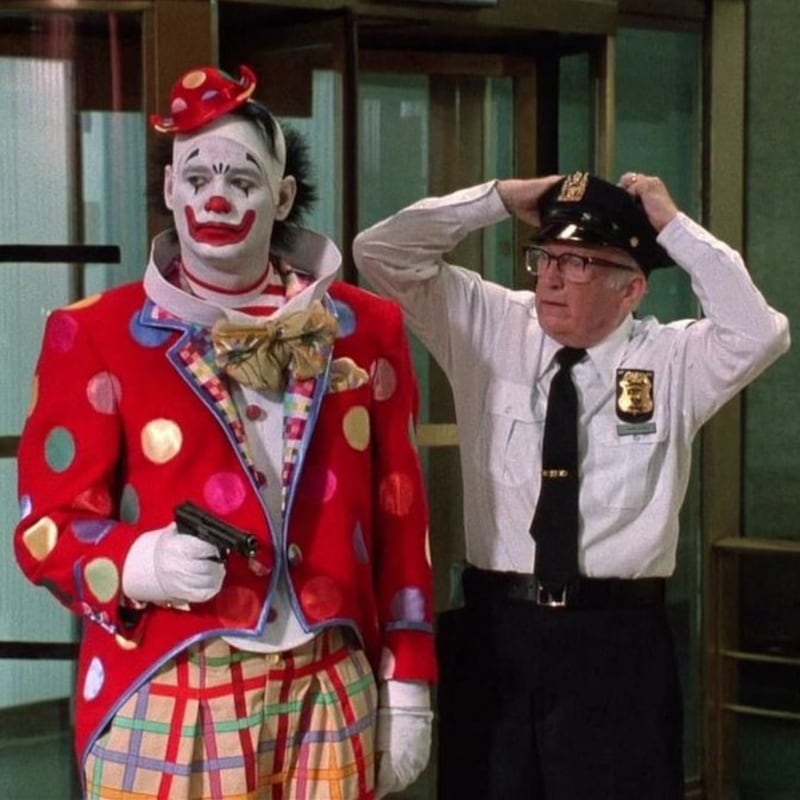The wires are alive with the news that Bill Murray is in Ireland to play golf. He will hack his way through courses such as Druids Glen, Rosapenna and Ballybunion for a YouTube series called The Links Life.
The format has been with us since those pro-celebrity golf things in the 1970s when Bruce Forsyth and Telly Savalas joshed about the weather in Gleneagles. Supported by Tourism Ireland and Fáilte Ireland, the project seeks to flog our bunkers and semi-roughs to the good burghers of Boulder and Beijing. Good luck to it.
We can guess what Murray gets from the project. A friend of the old country for a long time – he played the then-young Cat Laughs comedy festival in Kilkenny a quarter of a century ago – the actor will enjoy a holiday attacking a sport he enjoys. (Tourism Ireland confirmed that Bill Murray and his family paid for the cost of the trip, and it is contributing towards the costs of two film crew who are filming Murray for ‘The Links Life’)
So, em we don’t often feature other modes of transport. But Bill Murray on a to Belmullet is the best thing we’ve seen in ages. He’s here making a golf documentary & was at @CarneGolfLinks. ⛳️ ️♂️❤️#FillYourHeartWithIreland pic.twitter.com/sFOgoIhSqX
— Dublin Airport (@DublinAirport) August 18, 2021
If you have any worries about his swing, check out his beautiful drive at the Kawaguchiko Country Club in Sofia Coppola’s Lost in Translation. There are worse ways of spending the late summer.
Bill Murray travels the world in crumpled clothes that nobody else would match together. Nobody much cares who he is dating. None of the hoopla seems to impress him
What do the makers get from Murray? Plenty. Now 70, Bill Murray has managed the not-inconsiderable feat of remaining fashionable for half a century. He worked his way through Chicago's prestigious Second City improvisational group in the early 1970s before gaining mainstream fame with Saturday Night Live in the middle of that decade. He achieved a further jump up the ladder in hit movies such as Caddyshack, in 1980, and the massive Ghostbusters, in 1984. In recent decades he has moved towards a more-upmarket school of nonconformity with directors such as Wes Anderson and Jim Jarmusch.
Were there an annual Buster Keaton Award for deadpan then Murray would surely have dominated it as Rafael Nadal dominates the French Open. What really secures his enduring cool, however, is the notion that he exists outside the celebrity machine. He travels the world in crumpled clothes that nobody else would match together. Nobody much cares who he is dating. None of the hoopla seems to impress him.
From what we can judge this is not any sort of act. He apparently does not have an agent or manager. If you want to pass him a script you have to phone his own number and leave a message. It has been reported that this creaky system caused him to miss out on roles in films such as Monsters Inc and Who Framed Roger Rabbit. Does he care? If you miss out on Bill that's your problem, not his.
His reputation for being a tad difficult does little to dispel this perceived oddball status. A few years ago the Guardian dug out a quote on his behaviour from Harvey Weinstein, which, given the source, now reads somewhat unfortunately. “Being a Murray-ite is a religion, where you can behave as badly as you want to people, and they still love you,” the notorious producer said in 2014. “I used to feel guilty about behaving badly, and then I met Bill, and it feels so much better.”
To be fair, most of the stories concerning Murray – an alleged falling out with Chevy Chase, further alleged tensions with Richard Dreyfuss – date from decades ago. The man whom Dan Aykroyd labelled the Murricane seems to have matured into a less volatile eccentric. "I remember a friend said to me a while back, 'You have a reputation,'" he commented recently. "And I said, 'What?' And he said, 'Yeah, you have a reputation of being difficult to work with.' But I only got that reputation from people I didn't like working with, or people who didn't know how to work, or what work is. Jim, Wes and Sofia, they know what it is to work, and they understand how you're supposed to treat people."

That mention of Jim Jarmusch, Wes Anderson and Sofia Coppola helps define his current place in the entertainment ecosystem. In the very funny Quick Change from 1990 – still his only feature as director – Murray, playing a bank robber in circus disguise, is asked, "What the hell kind of clown are you?" Murray shifts not a muscle in his face as he replies, "The crying on the inside kind, I guess." Well, quite.
He was never easy on the red carpet. He has never been a hearty joker. It was recently reported that, in his early days on stage, he was saved from suicide by a glance of Jules Adolphe Breton’s painting The Song of the Lark at the Art Institute of Chicago. Following the failure in 1984 of The Razor’s Edge, an adaptation of the W Somerset Maugham novel that he wrote himself, Murray, still hot from Ghostbusters, moved away from acting to study philosophy at the Sorbonne University in Paris and didn’t return to film for four years. That is the sort of independent thinking that appeals to directors such as Jarmusch, Anderson and Coppola. That determination to plough his own quiet furrow has kept him relevant and kept him in style.
Do not let his YouTube jaunt fool you into thinking he is sliding into semi-retirement. He has signed on for the next Wes Anderson film and will reprise his role as Peter Venkman for the imminent Ghostbusters: Afterlife. We may have the young peasant girl in The Song of the Lark to thank for his creative longevity.
‘Well, there’s a girl who doesn’t have a lot of prospects,” he recalls thinking. “But the sun is coming up anyway, and she’s got another chance at it.’ So I think that gave me some sort of feeling that I, too, am a person and get another chance every day the sun comes up.”
* This article was updated on August 19th





















